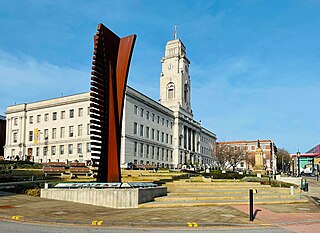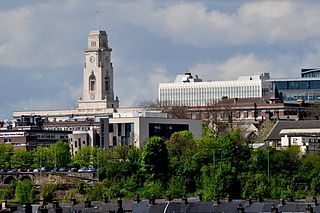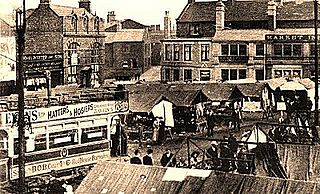
Barnsley is a market town in South Yorkshire, England. It is the main settlement of the Metropolitan Borough of Barnsley and the fourth largest settlement in South Yorkshire. The town's population was 96,888 in 2021, while the wider borough had a population of 244,600 in the 2021 census.

Grimethorpe is a village in the metropolitan borough of Barnsley in South Yorkshire, England. As of the 2011 census it has a population of 4,672. Grimethorpe is located in eastern Barnsley, and until the local government reorganisation of 1974, it was part of the Hemsworth district and constituency. The village is part of the North East ward of Barnsley Metropolitan Borough Council.

The Metropolitan Borough of Barnsley is a metropolitan borough in South Yorkshire, England; the main settlement is Barnsley and other notable towns include Penistone, Wombwell and Hoyland.

Shafton is a civil parish in the Metropolitan Borough of Barnsley in South Yorkshire, England, on the border with West Yorkshire. At the 2001 census it had a population of 2,840, increasing to 3,447 at the 2011 Census. The parish contains the villages of Shafton and Shafton Two Gates.

Royston is a suburban village within the Metropolitan borough of Barnsley, in South Yorkshire, England. Historically, the village formed part of the West Riding of Yorkshire, but was incorporated into the Metropolitan borough of Barnsley in 1974 and is now on the border with West Yorkshire. It is part of the Barnsley Central borough constituency, and has a population of 10,728. It is situated 4 miles (6.4 km) north-east of Barnsley, and 6 miles (9.7 km) south-east of Wakefield.

Athersley is a village in the metropolitan borough of Barnsley, South Yorkshire, England.

Carlton is a village in the Metropolitan Borough of Barnsley in South Yorkshire, England. It is situated between the villages of Athersley and Royston. The village is split into two parts, one half in the Monk Bretton ward and the rest in the Royston ward of the Barnsley MBC. It was built up on coking and coal mining industries and now has one of the largest industrial estates within the surrounding area. In the industrial estate lies a glass recycling plant, called Rexam. To its east stands the Mr Kipling cake factory, owned by Premier Foods. Until 1974 it was in the West Riding of Yorkshire.

Lundwood is a village in Barnsley in South Yorkshire, England.

Cudworth is a village in the Metropolitan Borough of Barnsley in South Yorkshire, England. It had a population of 10,977 in the 2011 Census.

Monk Bretton is a village in the Metropolitan Borough of Barnsley in South Yorkshire, England. It lies approximately two miles north-east from Barnsley town centre. Until 1974 it was in the West Riding of Yorkshire.

The Barnsley and District Electric Traction Co was an electric tramway network serving the town of Barnsley, South Yorkshire.

Oaks Viaduct spanned the Dearne Valley, in South Yorkshire, England. The viaduct was 1,087 feet (331 m) long and crossed Pontefract Road at Hoyle Mill, and spanned the Dearne Valley including the Dearne and Dove Canal and the Barnsley Coal Railway. It carried the Midland Railway's Cudworth-Barnsley branch. It opened to goods traffic in 1869 and to passenger traffic in 1870. On the Barnsley side the line gave access to Barnsley Main Colliery. The line also served Monk Bretton Colliery and a stub at the Cudworth end is still used to deliver sand to Redfearn's Glass Works at Monk Bretton.

Ryhill is a small village and civil parish situated on the B6428 road in West Yorkshire, England approximately 6 miles (10 km) north-east of Barnsley. It has a population of 2,628, increasing to 2,894 at the 2011 census.

The A6195 road runs through the Dearne Valley in South Yorkshire, England.
Priory School and Sports College was a comprehensive secondary school in Barnsley, South Yorkshire, England. In September 2011 it merged with Willowgarth High School to form Shafton Advanced Learning Centre. It served the area including Lundwood, Monk Bretton, Cudworth and Cundy Cross.
Frickley & South Elmsall Colliery was opened by the Carlton Main Colliery Company Ltd in 1903 in South Elmsall, in Yorkshire, England.

The County Borough of Barnsley, and its predecessor, the Municipal Borough of Barnsley, was a local government district in the West Riding of Yorkshire, England, from 1869 to 1974.

Wharncliffe Woodmoor 1, 2 and 3 colliery was a coal mine that was located at the junction of Laithes Lane and Carlton Road, about 2 miles (3.2 km) north-east of Barnsley, South Yorkshire and a quarter mile east of Staincross and Mapplewell railway station, on the Great Central Railway. The branch line junction was about 200 feet (61 m) from Staincross that connected it to the colliery via a private line. The line finished up between the three main shafts and the coking ovens.
Barrow Colliery was a coal mine in Worsborough, South Yorkshire, England. It was first dug in 1873, with the first coal being brought to the surface in January 1876. It was the scene of a major incident in 1907 when seven miners died. After 109 years of coaling operations, the mine was closed in May 1985.

















